Impact of Ag on the Limit of Detection towards NH3-Sensing in Spray-Coated WO3 Thin-Films
Abstract
:1. Introduction
2. Experimental
3. Results and Discussion
3.1. Structural and Morphological Analysis
3.2. XPS Studies
3.3. Gas Sensing Properties
4. Conclusions
Author Contributions
Funding
Institutional Review Board Statement
Informed Consent Statement
Data Availability Statement
Acknowledgments
Conflicts of Interest
References
- Vinayakumar, K.B.; Martins, M.; Gaspar, J.; Hutter, T. Ionization Potential Tunable Pyroelectric Ambient Pressure Multi-Gas Detection Platform. In Proceedings of the IEEE International Conference on Micro Electro Mechanical Systems, Gainesville, FL, USA, 25–29 January 2021; pp. 795–798. [Google Scholar]
- Qi, X.; Liu, J.; Liang, Y.; Li, J.; He, S. The response mechanism of surface acoustic wave gas sensors in real time. Jpn. J. Appl. Phys. 2019, 58, 014001. [Google Scholar] [CrossRef]
- Vinayakumar, K.B.; Gund, V.; Lambert, N.; Lodha, S.; Lal, A. Enhanced lithium niobate pyroelectric ionizer for chip-scale ion mobility-based gas sensing. In Proceedings of the 2016 IEEE Sensors, Orlando, FL, USA, 30 October–3 November 2016; pp. 3–5. [Google Scholar]
- Liu, H.; Shen, W.; Chen, X. A room temperature operated ammonia gas sensor based on Ag-decorated TiO2 quantum dot clusters. RSC Adv. 2019, 9, 24519–24526. [Google Scholar] [CrossRef] [Green Version]
- Ravichandran, K.; Santhosam, A.J.; Sridharan, M. Effect of tungsten doping on the ammonia vapour sensing ability of ZnO thin films prepared by a cost effective simplified spray technique. Surf. Interfaces 2020, 18, 100412. [Google Scholar] [CrossRef]
- Jeevitha, G.; Abhinayaa, R.; Mangalaraj, D.; Ponpandian, N.; Meena, P.; Mounasamy, V.; Madanagurusamy, S. Porous reduced graphene oxide (rGO)/WO3 nanocomposites for the enhanced detection of NH3 at room temperature. Nanoscale Adv. 2019, 1, 1799–1811. [Google Scholar] [CrossRef] [Green Version]
- Tesfamichael, T.; Piloto, C.; Arita, M.; Bell, J. Fabrication of Fe-doped WO3 thin films for NO2 sensing at lower operating temperature. Sens. Actuators B Chem. 2015, 221, 393–400. [Google Scholar] [CrossRef] [Green Version]
- Nakarungsee, P.; Srirattanapibul, S.; Issro, C.; Tang, I.M.; Thongmee, S. High performance Cr doped ZnO by UV for NH3 gas sensor. Sens. Actuators A Phys. 2020, 314, 112230. [Google Scholar] [CrossRef]
- Yu, H.; Li, J.; Li, Z.; Tian, Y.; Yang, Z. Enhanced formaldehyde sensing performance based on Ag@WO3 2D nanocomposite. Powder Technol. 2019, 343, 1–10. [Google Scholar] [CrossRef]
- Zeng, Y.; Hua, Z.; Tian, X.; Li, X.; Qiu, Z.; Zhang, C.; Wang, M.; Li, E. Selective detection of methanol by zeolite/Pd-WO3 gas sensors. Sens. Actuators B Chem. 2018, 273, 1291–1299. [Google Scholar] [CrossRef]
- Godbole, R.; Godbole, V.; Bhagwat, S. Palladium enriched tungsten oxide thin films: An efficient gas sensor for hazardous gases. Eur. Phys. J. B 2019, 92, 78. [Google Scholar] [CrossRef]
- Lu, R.; Zhong, X.; Shang, S.; Wang, S.; Tang, M. Effects of sintering temperature on sensing properties of WO3 and Ag–WO3 electrode for NO2 sensor. R. Soc. Open Sci. 2018, 5, 1–11. [Google Scholar] [CrossRef] [Green Version]
- Xu, L.; Yin, M.L.; Liu, S. Superior sensor performance from Ag@WO3 core-shell nanostructure. J. Alloys Compd. 2015, 623, 127–131. [Google Scholar] [CrossRef]
- Yuan, Z.; Zhang, J.; Meng, F.; Li, Y.; Li, R.; Chang, Y.; Zhao, J.; Han, E.; Wang, S. Highly Sensitive Ammonia Sensors Based on Ag-Decorated WO3 Nanorods. IEEE Trans. Nanotechnol. 2018, 17, 1252–1258. [Google Scholar] [CrossRef]
- Castillo, C.; Cabello, G.; Chornik, B.; Huentupil, Y.; Buono-Core, G.E. Characterization of photochemically grown Pd loaded WO3 thin films and its evaluation as ammonia gas sensor. J. Alloys Compd. 2020, 825, 154166. [Google Scholar] [CrossRef]
- Van Tong, P.; Hoa, N.D.; Van Duy, N.; Le, D.T.T.; Van Hieu, N. Enhancement of gas-sensing characteristics of hydrothermally synthesized WO3 nanorods by surface decoration with Pd nanoparticles. Sens. Actuators B Chem. 2016, 223, 453–460. [Google Scholar] [CrossRef]
- National Institute for Occupational Safety and Health; Centers for Disease Control; U.S. Department of Health and Human Services. Occupational Safety and Health Guideline for Ammonia. In Occupational Safety and Health Guidelines; U.S. Department of Health and Human Services: Washington, DC, USA, 1992; pp. 1–7. [Google Scholar]
- Kumar, N.; Sidhu, G.K.; Kumar, R. Correlation of synthesis parameters to the phase segregation and lattice strain in tungsten oxide nanoparticles. Mater. Res. Express 2019, 6, 075019. [Google Scholar] [CrossRef]
- Khemiri, N.; Khalfallah, B.; Abdelkader, D.; Kanzari, M. X-ray Diffraction Spectroscopy Studies of CuIn2n+1 S3n+2 Thin Films. J. Thin Film Sci. Technol. 2014, 3, 7–12. [Google Scholar] [CrossRef]
- Jia, Q.; Ji, H.; Bai, X. Selective sensing property of triclinic WO3 nanosheets towards ultra-low concentration of acetone. J. Mater. Sci. Mater. Electron. 2019, 30, 7824–7833. [Google Scholar] [CrossRef]
- Díaz-Reyes, J.; Castillo-Ojeda, R.; Galván-Arellano, M.; Zaca-Moran, O. Characterization of WO3 thin films grown on silicon by HFMOD. Adv. Condens. Matter Phys. 2013, 2013, 591787. [Google Scholar] [CrossRef] [Green Version]
- Xu, L.; Yin, M.L.; Liu, S. Agx@WO3 core-shell nanostructure for LSP enhanced chemical sensors. Sci. Rep. 2014, 4, 1–7. [Google Scholar] [CrossRef] [Green Version]
- Bittencourt, C.; Llobet, E.; Ivanov, P.; Vilanova, X.; Correig, X.; Silva, M.A.P.; Nunes, L.A.O.; Pireaux, J.J. Ag induced modifications on WO3 films studied by AFM, Raman and x-ray photoelectron spectroscopy. J. Phys. D Appl. Phys. 2004, 37, 3383–3391. [Google Scholar] [CrossRef]
- Shigesato, Y.; Murayama, A.; Kamimori, T.; Matsuhiro, K. Characterization of evaporated amorphous WO3 films by Raman and FTIR spectroscopies. Appl. Surf. Sci. 1988, 34, 804–811. [Google Scholar] [CrossRef]
- Ex, C.; Juan, S.; Km, M.; Claudio, S.; Manuel, S.; Av, U. Obtaining of films of tungsten trioxide (WO3) by resistive heating of a tungsten filament. Superf. Vacío 2008, 21, 12–17. [Google Scholar]
- Cai, G.-F.; Wang, X.-L.; Zhou, D.; Zhang, J.-H.; Xiong, Q.-Q.; Gu, C.-D.; Tu, J.-P. Hierarchical structure Ti-doped WO3 film with improved electrochromism in visible-infrared region. RSC Adv. 2013, 3, 6896–6905. [Google Scholar] [CrossRef]
- Wang, Y.; Cui, X.; Yang, Q.; Liu, J.; Gao, Y.; Sun, P.; Lu, G. Preparation of Ag-loaded mesoporous WO3 and its enhanced NO2 sensing performance. Sens. Actuators B Chem. 2016, 225, 544–552. [Google Scholar] [CrossRef]
- Adilakshmi, G.; Reddy, R.S.; Reddy, A.S.; Reddy, P.S.; Reddy, C.S. Ag-doped WO3 nanostructure films for organic volatile gas sensor application. J. Mater. Sci. Mater. Electron. 2020, 31, 12158–12168. [Google Scholar] [CrossRef]
- Ta, T.K.H.; Tran, T.N.H.; Tran, Q.M.N.; Pham, D.P.; Pham, K.N.; Cao, T.T.; Kim, Y.S.; Tran, D.L.; Ju, H.; Phan, B.T. Surface Functionalization of WO3 Thin Films with (3-Aminopropyl)triethoxysilane and Succinic Anhydride. J. Electron. Mater. 2017, 46, 3345–3352. [Google Scholar] [CrossRef]
- Yu, W.; Shen, Z.; Peng, F.; Lu, Y.; Ge, M.; Fu, X.; Sun, Y.; Chen, X.; Dai, N. Improving gas sensing performance by oxygen vacancies in sub-stoichiometric WO3−x. RSC Adv. 2019, 9, 7723–7728. [Google Scholar] [CrossRef] [Green Version]
- Baig, U.; Gondal, M.A.; Rehman, S.; Akhtar, S. Facile synthesis, characterization of nano-tungsten trioxide decorated with silver nanoparticles and their antibacterial activity against water-borne gram-negative pathogens. Appl. Nanosci. 2020, 10, 851–860. [Google Scholar] [CrossRef]
- Zhang, G.; Li, C.; Cheng, F.; Chen, J. ZnFe2O4 tubes: Synthesis and application to gas sensors with high sensitivity and low-energy consumption. Sens. Actuators B Chem. 2007, 120, 403–410. [Google Scholar] [CrossRef]
- Kumar, M.; Singh, B.; Yadav, P.; Bhatt, V.; Kumar, M.; Singh, K.; Abhyankar, A.C.; Kumar, A.; Yun, J.-H. Effect of structural defects, surface roughness on sensing properties of Al doped ZnO thin films deposited by chemical spray pyrolysis technique. Ceram. Int. 2017, 43, 3562–3568. [Google Scholar] [CrossRef]
- Lee, J.M.; Lee, W. Effects of surface roughness on hydrogen gas sensing properties of single Pd nanowires. J. Nanosci. Nanotechnol. 2011, 11, 2151–2154. [Google Scholar] [CrossRef] [PubMed]
- Arun Kumar, K.D.; Valanarasu, S.; Ponraj, J.S.; Fernandes, B.J.; Shkir, M.; AlFaify, S.; Murahari, P.; Ramesh, K. Effect of Er doping on the ammonia sensing properties of ZnO thin films prepared by a nebulizer spray technique. J. Phys. Chem. Solids 2020, 144, 109513. [Google Scholar] [CrossRef]
- Kolhe, P.S.; Mutadak, P.; Maiti, N.; Sonawane, K.M. Synthesis of WO3 nanoflakes by hydrothermal route and its gas sensing application. Sens. Actuators A Phys. 2020, 304, 111877. [Google Scholar] [CrossRef]
- Jiménez, I.; Vilà, A.M.; Calveras, A.C.; Morante, J.R. Gas-sensing properties of catalytically modified WO3 with copper and vanadium for NH3 detection. IEEE Sens. J. 2005, 5, 385–390. [Google Scholar] [CrossRef]
- Wang, S.; Zhang, H.; Li, H.; Wu, R.; Hua, Z.; Wu, Y.; Tian, X. NH3 sensing properties with Cr-loaded WO3 nanosheets. Chem. Lett. 2020, 49, 1421–1425. [Google Scholar] [CrossRef]
- Dien, N.D.; Phuoc, L.H.; Hien, V.X.; Vuong, D.D.; Chien, N.D. Hydrothermal Synthesis and Ammonia Sensing Properties of WO3/Fe2O3 Nanorod Composites. J. Electron. Mater. 2017, 46, 3309–3316. [Google Scholar] [CrossRef]


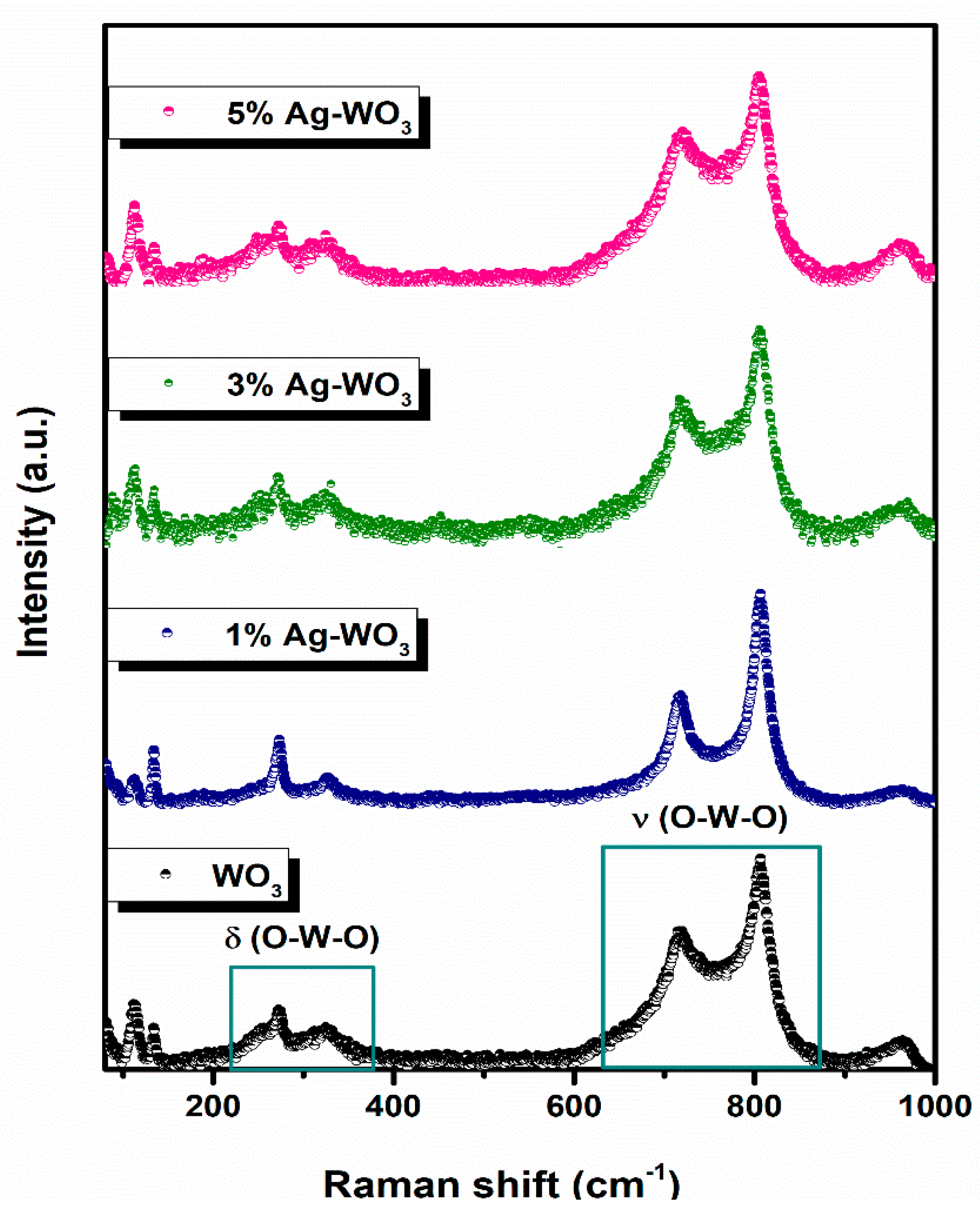
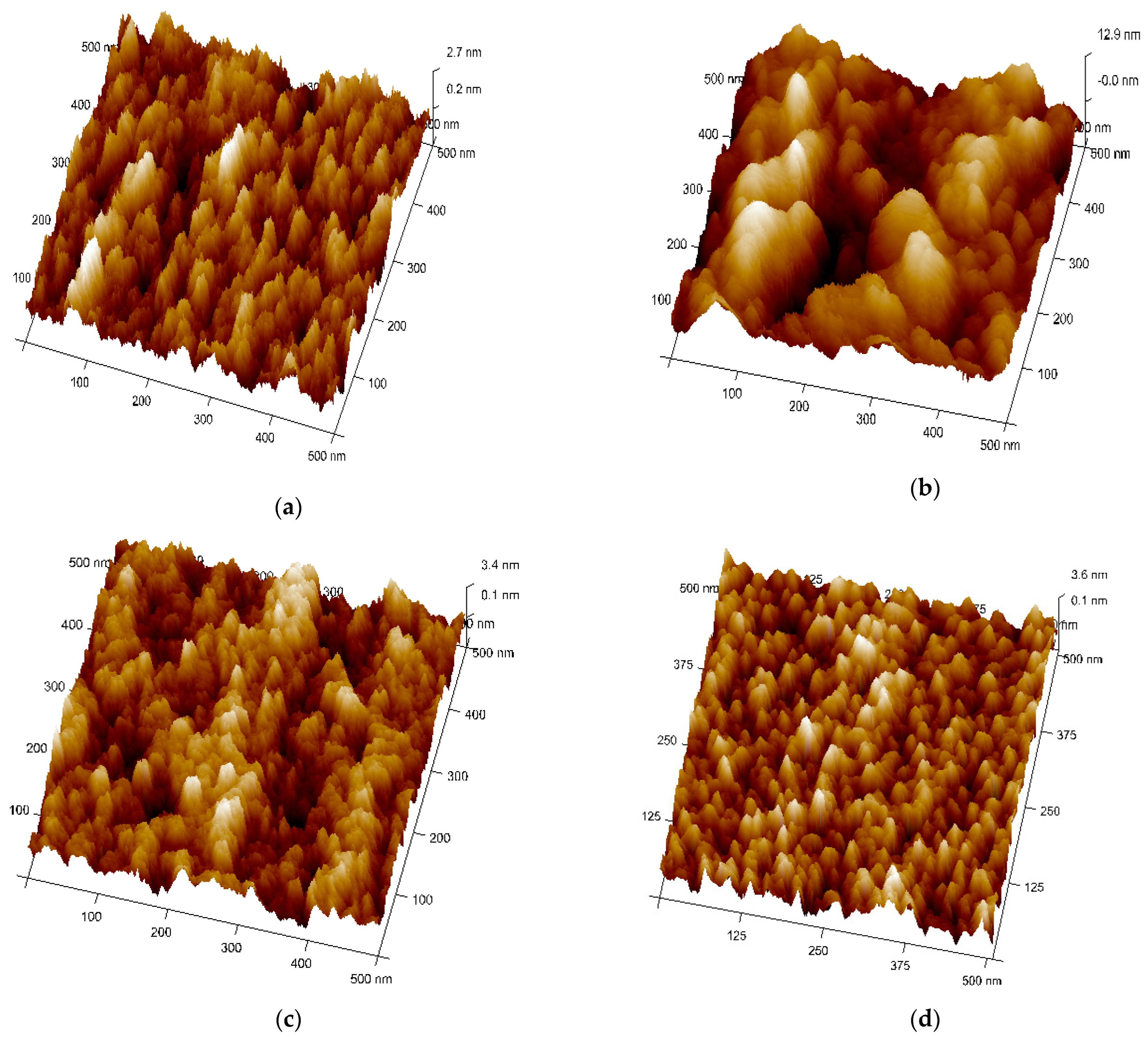



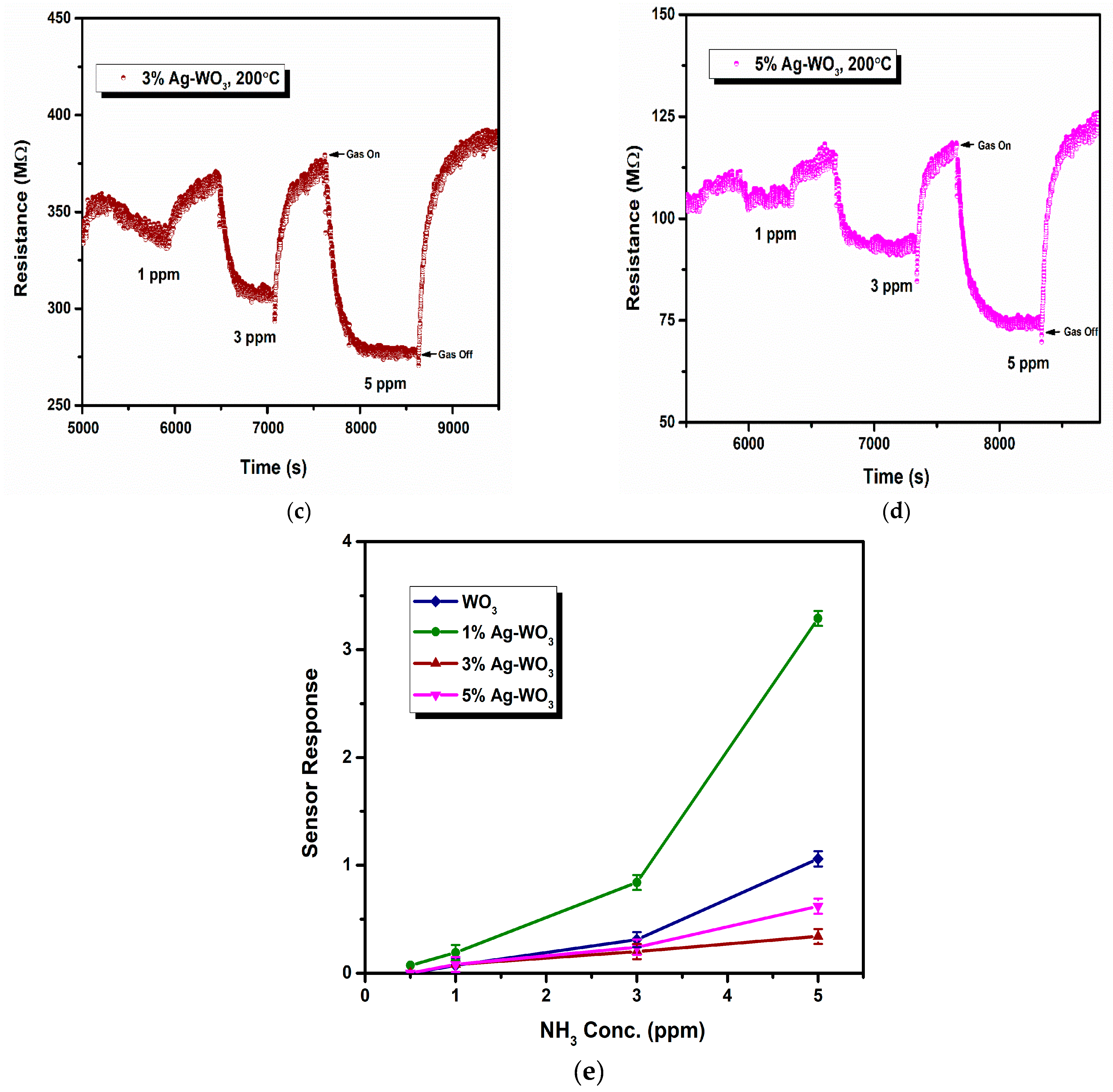


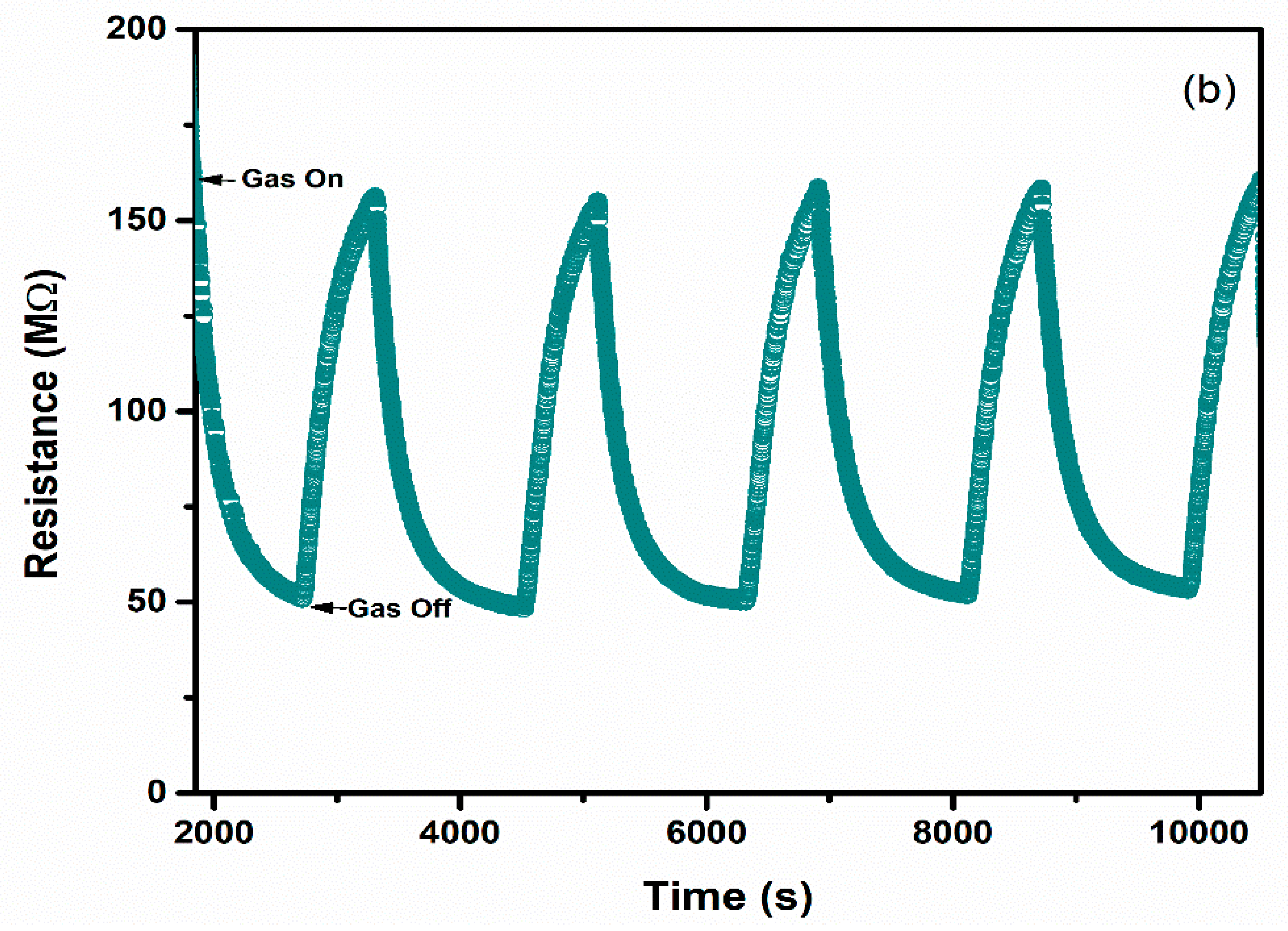
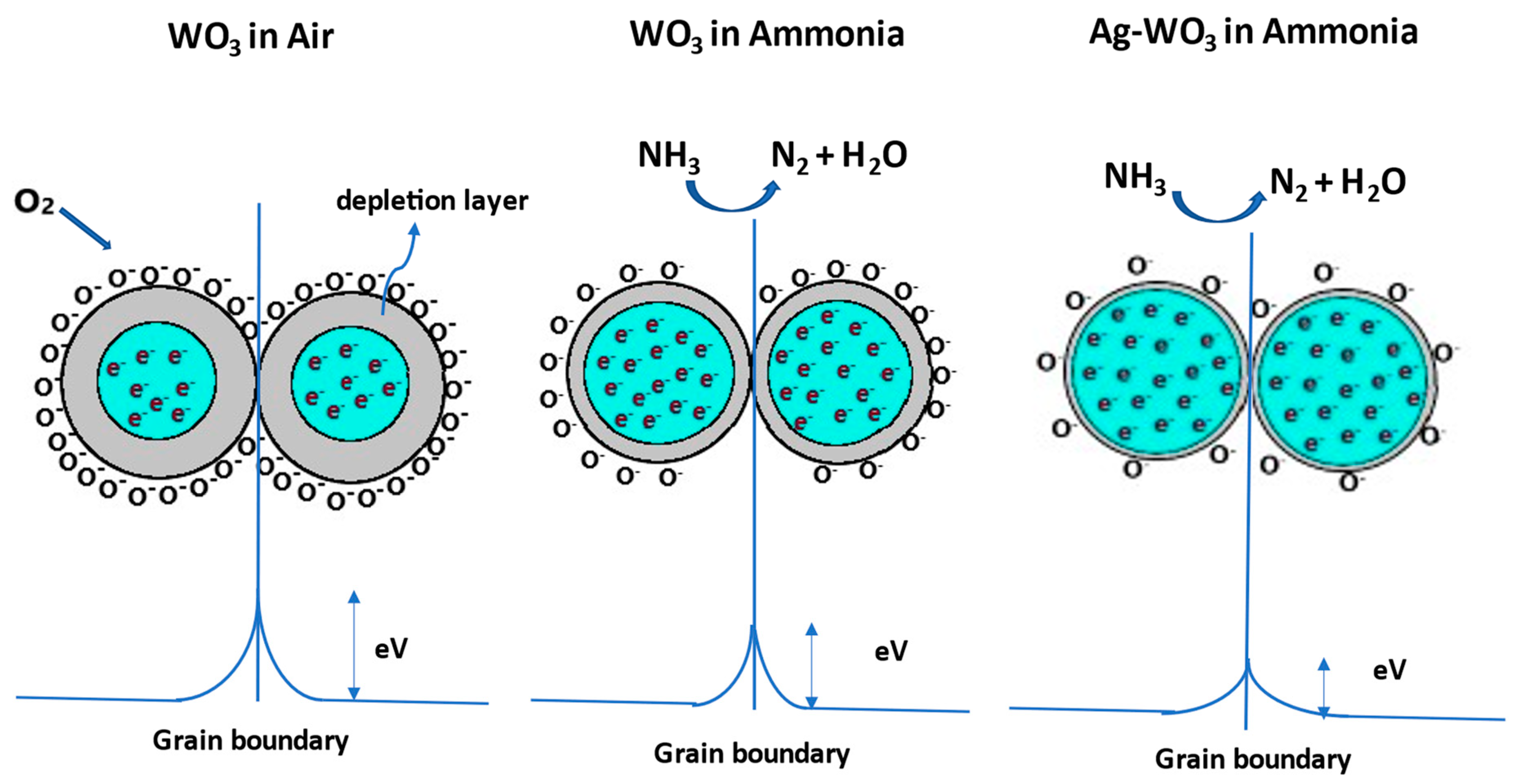
| Ag Conc. (wt.%) | 2θ, (200) | Crystallite Size D (nm) | Dislocation Density δ (×1015 m−2) | Microstrain ε (×10−3) | RMS Surface Roughness (nm) |
|---|---|---|---|---|---|
| 0 | 24.12° | 13.0 | 5.9 | 2.7 | 0.8 |
| 1 | 24.16° | 13.6 | 5.4 | 2.5 | 4.3 |
| 3 | 24.14° | 11.5 | 7.5 | 3 | 1.1 |
| 5 | 24.14° | 14.7 | 4.6 | 2.4 | 0.6 |
| Material | Method of Deposition | Limit of Detection | Operating Temperature (°C) | Reference |
|---|---|---|---|---|
| Pd–WO3 films | Spray pyrolysis | 10 ppm | 225 | [9] |
| Ag–WO3 nanorods | Hydrothermal | 50 ppb | 450 | [12] |
| WO3 nanoflakes | Spray Pyrolysis | 120 ppm | 150 | [36] |
| V–WO3 films | Soft-chemical route | 100 ppm | 300 | [37] |
| Cu–WO3 films | Soft-chemical route | 100 ppm | 200 | [37] |
| Cr–WO3 nanosheets | Acidification with impregnation | 2 ppm | 400 | [38] |
| WO3–Fe2O3 nanocomposites | Hydrothermal | 25 ppm | 300 | [39] |
| Ag–WO3 films | Spray pyrolysis | 500 ppb | 200 | This work |
Publisher’s Note: MDPI stays neutral with regard to jurisdictional claims in published maps and institutional affiliations. |
© 2022 by the authors. Licensee MDPI, Basel, Switzerland. This article is an open access article distributed under the terms and conditions of the Creative Commons Attribution (CC BY) license (https://creativecommons.org/licenses/by/4.0/).
Share and Cite
Anusha; Ani, A.; Poornesh, P.; Antony, A.; Bhaghyesh; Shchetinin, I.V.; Nagaraja, K.K.; Chattopadhyay, S.; Vinayakumar, K.B. Impact of Ag on the Limit of Detection towards NH3-Sensing in Spray-Coated WO3 Thin-Films. Sensors 2022, 22, 2033. https://doi.org/10.3390/s22052033
Anusha, Ani A, Poornesh P, Antony A, Bhaghyesh, Shchetinin IV, Nagaraja KK, Chattopadhyay S, Vinayakumar KB. Impact of Ag on the Limit of Detection towards NH3-Sensing in Spray-Coated WO3 Thin-Films. Sensors. 2022; 22(5):2033. https://doi.org/10.3390/s22052033
Chicago/Turabian StyleAnusha, Aninamol Ani, P. Poornesh, Albin Antony, Bhaghyesh, Igor V. Shchetinin, K. K. Nagaraja, Saikat Chattopadhyay, and K. B. Vinayakumar. 2022. "Impact of Ag on the Limit of Detection towards NH3-Sensing in Spray-Coated WO3 Thin-Films" Sensors 22, no. 5: 2033. https://doi.org/10.3390/s22052033
APA StyleAnusha, Ani, A., Poornesh, P., Antony, A., Bhaghyesh, Shchetinin, I. V., Nagaraja, K. K., Chattopadhyay, S., & Vinayakumar, K. B. (2022). Impact of Ag on the Limit of Detection towards NH3-Sensing in Spray-Coated WO3 Thin-Films. Sensors, 22(5), 2033. https://doi.org/10.3390/s22052033









